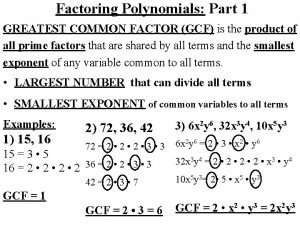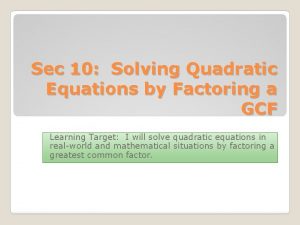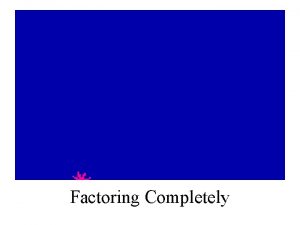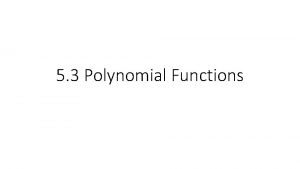Factoring Polynomial Functions I Factoring Methods A GCF





- Slides: 5

Factoring Polynomial Functions I. . Factoring Methods. *A) GCF: always try this one first. 1) Factor out the Greatest Common Factor (GCF) from each of the terms. (divide them by the GCF) 2) Write it in GCF (axn + … ) form. Example: 15 x 4 + 20 x 2 – 25 x = 0 (GCF is 5 x) 15 x 4 + 20 x 2 – 25 x 5 x 5 x ( 3 x 3 + 4 x – 5)

Factoring Polynomial Functions I. . Factoring Methods. B) Difference of Squares (2 terms). a 2 – b 2 = (a + b)(a – b) 1) Can you √ a & √ b ? If so, use Diff of Squares. Examples: 9 x 2 – 100 = 0 √ 9 x 2 – √ 100 (3 x + 10)(3 x – 10) 4 x 8 – 49 y 6 = 0 √ 4 x 8 - √ 49 y 6 (2 x 4 + 7 y 3)(2 x 4 – 7 y 3)

Factoring Polynomial Functions I. . Factoring Methods. C) Reverse FOIL (3 terms). x 2 + bx + c = 0 1) The “a” term is 1. 2) Find the factors of the “c” term that add or subtr. to give the “b” term. 3) Determine the signs needed to get the “b” term and put in (x + #) form. Example: x 2 + 5 x + 6 = 0 +6 1 • 6=7 (x + 2)(x + 3) 2 • 3=5

Factoring Polynomial Functions I. . Factoring Methods. D) Reverse FOIL (3 terms). ax 2 + bx + c = 0 1) The “a” term is NOT 1. 2) Find the factors of the “a • c” term that add / subtr. to give the “b” term. 3) Determine the signs needed to get the “b” term and put in (x + #) form. 4) Divide by the “a” and reduce fractions. 5) The bottom of the fraction goes in front of the x. Example: 12 x 2 – 7 x – 10 = 0 (x + 8/12) (x – 15/12) a • c = – 120 (x + 2/3) (x – 5/4) 8 • 15 = – 7 (3 x + 2) (4 x – 5)

Factoring Polynomial Functions I. . Factoring Methods. E) Quadratic Form: (3 terms). ax 2 n + bxn + c = 0 1) Same as Reverse FOIL from D) and E) except the exp is bigger. (The 1 st exp is exactly double the other exp. ) 2) Get the numbers & signs to put in the (ax + b) (cx + d) factors, and use ½ the biggest exp on the x term. Example: x 6 – 5 x 3 – 6 c = – 6 8 x 10 – 22 x 5 – 21 = 0 a • c = -168 1 • 6 = – 5 6 • 28 = – 22 (x 3 + 1)(x 3 – 6) (x 5 + 6/8)(x 5 – 28/8) (4 x 5 + 3)(2 x 5 – 7)







